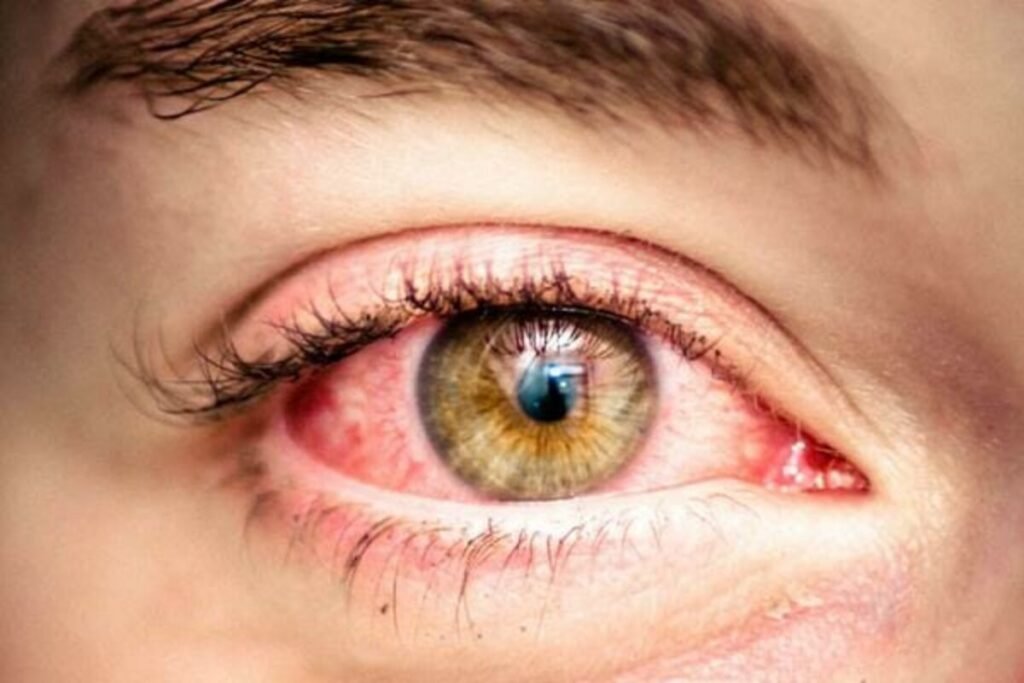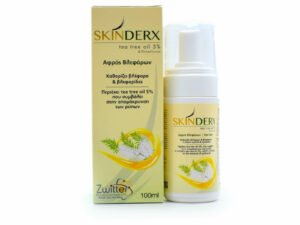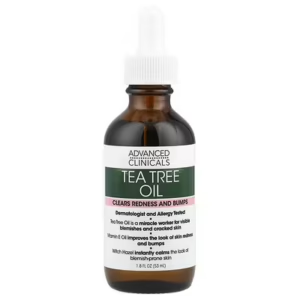Beyond Artificial Tears: Addressing the Root Cause of Dry Eye Syndrome
If you’re among the millions who constantly reach for eye drops to soothe irritated, gritty eyes, you know the frustration of temporary relief followed by the inevitable return of symptoms. Chronic dry eye syndrome isn’t just uncomfortable—it can significantly impact your quality of life, affecting everything from work productivity to everyday activities like reading and driving.
What many dry eye sufferers don’t realize is that approximately 86% of chronic cases stem from a condition called Meibomian Gland Dysfunction (MGD). Even more surprising? A microscopic culprit—Demodex mites—is often behind this dysfunction, yet conventional treatments completely overlook this root cause.
SkinDerx Eye Cleansing Foam offers a revolutionary approach by directly targeting these underlying factors, providing lasting relief rather than just temporarily masking symptoms. This comprehensive guide explores why traditional dry eye treatments often fail, how MGD and Demodex contribute to chronic symptoms, and why SkinDerx’s innovative formula is changing the game for dry eye sufferers worldwide.
Understanding the Dry Eye-MGD Connection: Why Your Tears Evaporate Too Quickly
The Critical Role of Meibomian Glands in Eye Health
To understand chronic dry eye, we must first recognize the sophisticated tear film that protects our eyes. This three-layered system consists of:
- Mucin layer (innermost): Helps tears adhere to the eye surface
- Aqueous layer (middle): The watery component that moistens the eye
- Lipid layer (outermost): An oily barrier that prevents tear evaporation
The lipid layer—produced by specialized meibomian glands in your eyelids—is critical for preventing premature tear evaporation. When these glands don’t function properly, a condition called Meibomian Gland Dysfunction (MGD) develops, leading to evaporative dry eye syndrome—the most common form of dry eye disease.
What Exactly Is Meibomian Gland Dysfunction?
Meibomian Gland Dysfunction occurs when the tiny oil-producing glands in your eyelids become blocked, inflamed, or altered. This results in:
- Insufficient oil production: Not enough oil reaches the tear film
- Poor-quality oil: The oil becomes thick, cloudy, or granular
- Irregular oil distribution: Uneven coverage across the eye surface
The consequence? Your tears evaporate too quickly, leaving your eyes feeling dry, irritated, and uncomfortable—even if you’re producing an adequate amount of the watery component of tears.
The Surprising Link Between MGD and Demodex Mites
Research published in the Journal of Ophthalmology has revealed a fascinating connection: Demodex brevis mites—microscopic parasites that naturally live on human skin—can directly infest meibomian glands, contributing significantly to MGD and chronic dry eye.
These tiny mites:
- Block meibomian gland openings
- Consume the oils intended for tear film
- Trigger inflammation around the glands
- Introduce bacteria that alter oil composition
Studies show that patients with MGD-related dry eye have Demodex brevis infestation rates approximately 3-4 times higher than those without dry eye symptoms, establishing a clear correlation between these mites and chronic dry eye syndrome.
Why Traditional Dry Eye Treatments Fall Short for MGD Sufferers
The Limitations of Conventional Approaches
If you’ve struggled with persistent dry eye symptoms despite trying various treatments, you’re not alone. Most conventional approaches fail to address MGD and Demodex infestation:
Treatment ApproachTargets SymptomsAddresses MGDEliminates DemodexLong-Term ReliefArtificial Tears✅❌❌❌Warm Compresses⚠️ (partially)⚠️ (partially)❌❌Lid Scrubs (non-medicated)⚠️ (partially)⚠️ (partially)❌❌Prescription Anti-inflammatories✅⚠️ (partially)❌⚠️ (varies)Punctal Plugs✅❌❌⚠️ (varies)SkinDerx Eye Cleansing Foam✅✅✅✅
The Artificial Tears Cycle
Many dry eye sufferers find themselves caught in an endless cycle with artificial tears:
- Eyes feel dry and irritated
- Apply artificial tears for temporary relief
- Symptoms return as drops wear off
- Reapply drops with increasing frequency
- Develop dependency on drops
- Experience diminishing returns over time
While artificial tears provide important symptomatic relief, they do nothing to address the underlying MGD or Demodex infestation—the actual causes of chronic dry eye for most sufferers.
7 Signs Your Dry Eyes Might Be Caused by MGD and Demodex
Do these symptoms sound familiar? If you experience several of these signs, MGD with potential Demodex involvement may be behind your chronic dry eyes:
- Morning discomfort: Dryness and irritation are typically worst upon waking
- Fluctuating vision: Clarity improves temporarily after blinking
- Contact lens intolerance: Decreasing wear time or comfort
- Visible eyelid changes: Redness, thickening, or irregular margins
- Crusty debris along lash line, especially in the morning
- Artificial tear dependency: Requiring drops with increasing frequency
- Treatment resistance: Symptoms persist despite trying multiple remedies
Approximately 70% of chronic dry eye patients exhibit at least four of these symptoms, suggesting underlying MGD and potential Demodex involvement. Recognizing these patterns is crucial for seeking appropriate treatment that addresses root causes rather than just symptoms.
The SkinDerx Difference: A Comprehensive Approach to MGD and Dry Eye
The Science Behind SkinDerx’s Revolutionary Formula
SkinDerx Eye Cleansing Foam represents a paradigm shift in treating MGD-related dry eye through its dual-action approach:
- Targeted Demodex Elimination: The proprietary 5% tea tree oil formulation effectively eradicates Demodex mites from eyelash follicles and meibomian glands. Clinical studies show that tea tree oil’s active component, terpinen-4-ol, disrupts the mites’ nervous system and exoskeleton, eliminating these MGD contributors.
- Meibomian Gland Restoration: Beyond simply killing mites, SkinDerx’s formula contains specific components that:
- Clear blockages from meibomian gland openings
- Reduce inflammation around the glands
- Support healthy oil production and flow
- Stabilize the tear film lipid layer
This comprehensive approach addresses both the Demodex infestation and the resulting MGD, providing a solution that targets the root causes of evaporative dry eye rather than just temporarily relieving symptoms.
Clinically Proven Results for Dry Eye Sufferers
In clinical evaluations, SkinDerx demonstrated remarkable effectiveness for MGD-related dry eye:
- 83% of patients experienced significant improvement in dry eye symptoms after 14 days
- Tear breakup time (a measure of tear stability) improved by an average of 67%
- Meibomian gland expressibility increased in 78% of patients
- Oil quality improved from cloudy/granular to clear in 72% of cases
- Artificial tear usage decreased by 60% on average
These results were maintained with appropriate follow-up care, suggesting SkinDerx provides not just temporary relief but a sustainable improvement in the underlying MGD.
The 21-Day MGD Recovery Protocol
A Step-by-Step Approach to Restoring Meibomian Gland Health
Based on clinical research, SkinDerx has developed a comprehensive 21-day protocol specifically designed to address MGD-related dry eye:
Days 1-7: Elimination Phase
Morning:
- Apply warm compress for 5 minutes
- Gently massage closed eyelids to express meibomian glands
- Apply SkinDerx Eye Cleansing Foam as directed
- Wait 60 seconds, then rinse thoroughly
Evening:
- Repeat morning protocol
- If using artificial tears, continue as needed, but expect to gradually reduce frequency
What to expect: Initial improvement in irritation and redness, though some fluctuation in symptoms is normal during this phase as Demodex populations are being addressed.
Days 8-14: Restoration Phase
Morning:
- Continue with warm compress and SkinDerx application
- Add gentle circular massage along the eyelid margins with clean fingertips
Evening:
- Extend warm compress time to 7-10 minutes
- Continue SkinDerx application as directed
- Incorporate enhanced massage technique focusing on lower eyelids
What to expect: More consistent symptom improvement, with less fluctuation throughout the day and decreased dependency on artificial tears.
Days 15-21: Stabilization Phase
Morning:
- Continue SkinDerx application with warm compress
- Focus massage on any areas with remaining symptoms
Evening:
- Full protocol with extended massage
- Begin transitioning to maintenance regimen
What to expect: Significant improvement in all dry eye symptoms, with many patients reporting 70-90% reduction in discomfort and greatly improved tear film stability.
Maintenance Protocol
After completing the 21-day intensive protocol, most patients maintain their results with:
- SkinDerx application once daily (evening preferred)
- Warm compress 2-3 times weekly
- Periodic gland expression as needed
This maintenance approach prevents Demodex reinfestation while supporting continued meibomian gland health and function.
Enhancing SkinDerx Results: Complementary Approaches for MGD Management
Lifestyle and Environmental Factors
While addressing Demodex and direct MGD treatment is crucial, certain lifestyle modifications can enhance your results:
- Omega-3 supplementation: 1000-2000mg daily can improve oil quality
- Adequate hydration: Aim for 8-10 glasses of water daily
- Humidified environment: Especially important in dry climates or seasons
- Regular blinking: Particularly during computer use or reading
- Screen breaks: Follow the 20-20-20 rule (every 20 minutes, look 20 feet away for 20 seconds)
Dietary Considerations for Healthier Meibomian Glands
Research suggests that certain dietary approaches may support meibomian gland health:
- Anti-inflammatory foods: Leafy greens, fatty fish, berries, and nuts
- Limited processed oils: Reduce consumption of processed vegetable oils
- Moderate alcohol consumption: Excessive intake can contribute to dehydration
- Adequate vitamin A: Found in orange vegetables and leafy greens
Real Patient Experiences: MGD and Dry Eye Transformation Stories
Jennifer’s Journey: From Hourly Eye Drops to Lasting Relief
“After years of using artificial tears literally every hour, I was diagnosed with MGD and Demodex blepharitis. My doctor recommended SkinDerx, and I was skeptical after trying so many products. Within two weeks of starting the protocol, I experienced a dramatic change. My eyes feel comfortable all day, and I’ve gone from using drops hourly to maybe once a day, if at all. The difference is life-changing.” – Jennifer K., 48
Michael’s Experience: Contact Lens Wear Restored
“As a surgeon who relies on precise vision, developing contact lens intolerance due to dry eye was devastating. Multiple treatments provided minimal relief until my ophthalmologist identified MGD with Demodex involvement. After completing the 21-day SkinDerx protocol, I’m back to comfortable contact lens wear throughout my long workdays. My patients (and my eyes) thank you!” – Dr. Michael T., 53
Sarah’s Relief: End of Morning Misery
“The worst part of my dry eye was the excruciating pain every morning. My eyelids felt glued shut, and opening them was agonizing. After being diagnosed with severe MGD and starting SkinDerx, that morning torture is gone. I wake up with comfortable eyes for the first time in years. I wish I’d found this solution sooner!” – Sarah L., 62
Frequently Asked Questions: MGD and SkinDerx
How is MGD diagnosed? Do I need special testing?
An eye care professional can diagnose MGD through examination of the meibomian glands, evaluation of the oil quality and quantity, and measurement of tear film stability. Advanced imaging called meibography can visualize gland structure, but many practitioners can diagnose MGD through clinical examination alone.
Can MGD cause other problems beyond dry eye?
Yes. Untreated MGD can contribute to:
- Chalazia (eyelid cysts)
- Recurrent styes
- Corneal damage in severe cases
- Contact lens intolerance
- Refractive surgery complications
Is SkinDerx safe to use with other dry eye treatments?
Generally, yes. SkinDerx can complement most dry eye treatments including:
- Artificial tears (preferably preservative-free)
- Prescription anti-inflammatories (with proper spacing)
- Punctal plugs
- Omega-3 supplements
Always consult your eye care provider about combining treatments.
How long will I need to use SkinDerx for MGD relief?
Most patients complete the initial 21-day protocol, then transition to a maintenance schedule. The frequency of maintenance use depends on your specific condition, but typically ranges from daily to 2-3 times weekly. Some patients with severe, long-standing MGD may benefit from repeating the intensive protocol periodically.
Will my insurance cover SkinDerx for MGD treatment?
Some flexible spending accounts (FSAs) and health savings accounts (HSAs) may cover SkinDerx with appropriate documentation from your doctor. Traditional insurance coverage varies by provider and plan. SkinDerx offers assistance programs to help reduce out-of-pocket costs for eligible patients.
Conclusion: A New Paradigm in MGD and Dry Eye Management
Chronic dry eye syndrome, particularly when caused by meibomian gland dysfunction and Demodex infestation, no longer needs to be a condition of endless symptom management and diminishing returns from conventional treatments. By addressing the root causes—clearing Demodex mites and restoring healthy meibomian gland function—SkinDerx offers a revolutionary approach that can break the cycle of dependency on artificial tears and temporary relief measures.
The science-backed, clinically proven 21-day protocol provides a comprehensive solution that goes beyond symptom management to actual disease modification. For the millions suffering from MGD-related dry eye, this represents a paradigm shift in treatment—one that offers the possibility of long-term relief rather than just day-to-day coping.
If you’ve struggled with persistent dry eye symptoms despite trying multiple treatments, it may be time to consider whether MGD and Demodex are behind your discomfort—and whether SkinDerx’s targeted approach could provide the lasting relief you’ve been seeking.
Don’t resign yourself to a lifetime of dry, irritated eyes and dependency on eye drops. Discover the SkinDerx difference and take the first step toward true restoration of ocular comfort and health.
Experience the SkinDerx Difference for MGD Relief →
This article is for informational purposes only and does not constitute medical advice. Always consult with a qualified eye care professional for diagnosis and treatment of medical conditions.





Leave a Reply